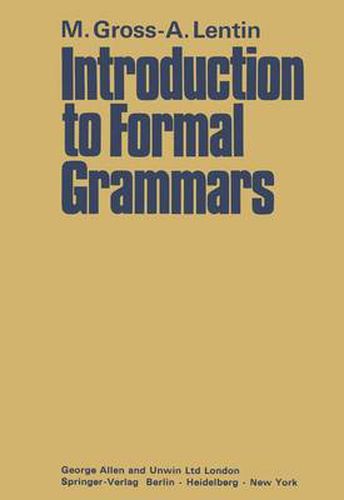Readings Newsletter
Become a Readings Member to make your shopping experience even easier.
Sign in or sign up for free!
You’re not far away from qualifying for FREE standard shipping within Australia
You’ve qualified for FREE standard shipping within Australia
The cart is loading…






This title is printed to order. This book may have been self-published. If so, we cannot guarantee the quality of the content. In the main most books will have gone through the editing process however some may not. We therefore suggest that you be aware of this before ordering this book. If in doubt check either the author or publisher’s details as we are unable to accept any returns unless they are faulty. Please contact us if you have any questions.
The present work originates in a course given by the authors during the last few years in various university departments and institutions, among which we should like to mention: the Centre de Linguistique Quantitative of the Faculte des Sciences de Paris, created at the instance of the late Professor Favard; the Chaire d'Analyse Numerique of the Faculte des Sciences de Paris (Professor Rene de Possel), curriculum of Troisieme Cycle; the Chaire de Physique Mathematique of the University of Toulouse (Professor M. Laudet), for the degree DiplOme d'Etudes Approfondies in the section Traitement de I'Information ; the department 1 of linguistics of the University of Pennsylvania (Professor Z. S. Harris); Institut de Programmation of the Faculte des Sciences de Paris for the troisieme niveau. the courses in the Written for purely didactic purposes, this Introduction to Formal Grammars makes no pretense to any scientific originality. Large portions of it have been borrowed from the fundamental and classic works cited in the bibliography, such as that of M. Davis, Computability and Unsolvability [9], and those of N. Chomsky, among others Formal Properties of Grammars [6]. Ineluctably, there are numerous borrowings made during a course, and the authors would like to acknowledge their debt to J. Pitrat for his lectures given in the Centre de Linguistique Quantitative mentioned above, and to M. Nivat for his work in connection 2 and transduction.
$9.00 standard shipping within Australia
FREE standard shipping within Australia for orders over $100.00
Express & International shipping calculated at checkout
This title is printed to order. This book may have been self-published. If so, we cannot guarantee the quality of the content. In the main most books will have gone through the editing process however some may not. We therefore suggest that you be aware of this before ordering this book. If in doubt check either the author or publisher’s details as we are unable to accept any returns unless they are faulty. Please contact us if you have any questions.
The present work originates in a course given by the authors during the last few years in various university departments and institutions, among which we should like to mention: the Centre de Linguistique Quantitative of the Faculte des Sciences de Paris, created at the instance of the late Professor Favard; the Chaire d'Analyse Numerique of the Faculte des Sciences de Paris (Professor Rene de Possel), curriculum of Troisieme Cycle; the Chaire de Physique Mathematique of the University of Toulouse (Professor M. Laudet), for the degree DiplOme d'Etudes Approfondies in the section Traitement de I'Information ; the department 1 of linguistics of the University of Pennsylvania (Professor Z. S. Harris); Institut de Programmation of the Faculte des Sciences de Paris for the troisieme niveau. the courses in the Written for purely didactic purposes, this Introduction to Formal Grammars makes no pretense to any scientific originality. Large portions of it have been borrowed from the fundamental and classic works cited in the bibliography, such as that of M. Davis, Computability and Unsolvability [9], and those of N. Chomsky, among others Formal Properties of Grammars [6]. Ineluctably, there are numerous borrowings made during a course, and the authors would like to acknowledge their debt to J. Pitrat for his lectures given in the Centre de Linguistique Quantitative mentioned above, and to M. Nivat for his work in connection 2 and transduction.